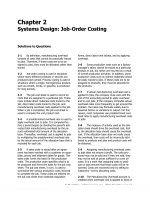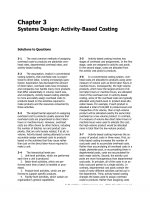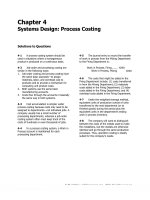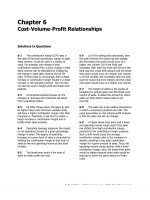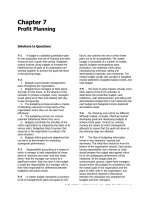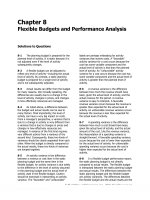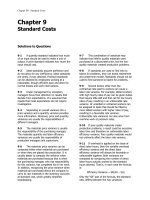Solution manual of managerial accounting by garrison noreen (13th ed ) appb
Bạn đang xem bản rút gọn của tài liệu. Xem và tải ngay bản đầy đủ của tài liệu tại đây (193.08 KB, 21 trang )
Appendix B
Profitability Analysis
Solutions to Questions
B-1
Absolute profitability measures the
impact on overall profits of adding or
dropping a particular segment, such as a
product or customer, without making any
other changes.
B-2
Relative profitability involves
ranking segments, each of which may be
absolutely profitable, for the purpose of
making trade-offs among the segments.
Such trade-offs are necessary when a
constraint exists. Otherwise, they are not
necessary.
B-3
Every business that seeks to
maximize profits has a constraint. No
business ever has had or ever will have
infinite profits. Whatever prevents a
business from attaining more profits is its
constraint. The constraint might be a
production constraint, it might be
managerial time or talent, or it might be
some internal policy that prevents the firm
from progressing, but every profit-seeking
organization faces at least one constraint.
The same is true for almost all nonprofit
organizations, which generally seek more
of something—be it more health care,
more land preserved from development,
more art, or some other objective.
B-4
The absolute profitability of a
segment is measured by the difference
between the incremental revenues from
the segment and the incremental
(avoidable) costs of the segment.
Consequently, to measure absolute
profitability, one would need the
incremental revenues and costs of the
segment.
B-5
The relative profitability of a
segment is measured by the profitability
index, which is computed by dividing the
incremental profit from the segment by
the amount of the constrained resource
required by the segment. Consequently, to
measure relative profitability, one would
need the incremental profit from the
segment and the amount of the
constrained resource required by the
segment.
B-6
A volume trade-off decision
involves trading off units of one product
for another. In such decisions fixed costs
are usually irrelevant and the products can
be ranked by dividing their unit
contribution margins by the amount of the
constrained resource required by one unit
of the product.
B-7
The selling price of a new product
should at least cover its variable costs and
opportunity costs. The opportunity costs
can be determined by multiplying the
opportunity cost per unit of the
constrained resource by the amount of the
constrained resource required by a unit of
the new product. In addition, the selling
price should cover any avoidable fixed
costs of the product. Exactly how much of
the avoidable fixed costs should be
covered by each unit is difficult to
determine a priori because the future unit
sales volume of a product is not known
with certainty.
.
© The McGraw-Hill Companies, Inc., 2010. All rights reserved.
212
Managerial Accounting, 13th Edition
Exercise B-1 (30 minutes)
1. This exercise can be solved by first computing the profitability
index of each new ride and then ranking the rides based on
that profitability index:
Ride 1.....
Ride 2.....
Ride
Ride
Ride
Ride
Ride
Ride
Ride
Ride
Ride
Ride
Ride
Ride
Ride
Ride
Ride
Ride
Ride
3.....
4.....
5.....
6.....
7.....
8.....
9.....
10. . .
7.....
1.....
4.....
6.....
2.....
9.....
5.....
3.....
10. . .
Safety
Enginee
Net
r Time
Present
Require
Value
d
(A)
(B)
$1,268,20
340
0
$1,152,00
360
0
$649,600
320
$644,100
190
$540,000
250
$539,200
160
$462,000
110
$457,200
360
$403,200
180
$387,500
250
Profitabili
ty Index
$4,200
$3,730
$3,390
$3,370
$3,200
$2,240
$2,160
$2,030
$1,550
Safety
Enginee
r Time
Require
d
110
340
190
160
360
180
250
320
250
Profitabili
ty Index
(A) ÷ (B)
$3,730
$3,200
$2,030
$3,390
$2,160
$3,370
$4,200
$1,270
$2,240
$1,550
Cumulati
ve
Amount
of Safety
Engineer
Time
Required
110
450
640
800
1,160
1,340
1,590
1,910
2,160
© The McGraw-Hill Companies, Inc., 2010. All rights reserved.
213
Managerial Accounting, 13th Edition
Ride 8.....
$1,270
360
2,520
Given the 1,590 hours of safety engineer time available, the
seven rides above the line in the above table should be built.
© The McGraw-Hill Companies, Inc., 2010. All rights reserved.
Solutions Manual, Profitability Analysis Appendix
214
Exercise B-1 (continued)
2. The total net present value for the seven new rides to be built
is computed as follows:
Ride 7......
Ride 1......
Ride 4......
Ride 6......
Ride 2......
Ride 9......
Ride 5......
$ 462,00
0
1,268,20
0
644,100
539,200
1,152,00
0
403,200
540,00
0
$5,008,7
00
Notes:
(a) Both the safety engineer’s time and the individual projects
would have to be very carefully scheduled to make sure that
all projects are completed on time. We have assumed that the
1,590 hours of available safety engineer time does not include
hours that have been set aside as a buffer to provide
protection from inevitable disruptions in the schedule.
(b) If the cumulative amount of safety engineer time required did
not exactly consume the total amount of time available, some
adjustment might be required in which projects are accepted
to ensure that the best plan is selected.
© The McGraw-Hill Companies, Inc., 2010. All rights reserved.
215
Managerial Accounting, 13th Edition
Exercise B-2 (30 minutes)
1. There is not enough capacity in the bottleneck operation to satisfy demand for all four
products. The total amount of time available in the bottleneck operation is 1,800 hours,
but 2,700 hours would be required to satisfy demand as shown below:
Adironda
ck
Annual demand in units (a). .
80
Hours required in the
bottleneck operation per
unit (b)..............................
5
Total hours required in the
bottleneck operation
(a) × (b)............................
400
Lake
Huron
120
Oysterma
n
Voyageur
100
140
4
7
8
480
700
1,120
Total
2,700
2. The profitability index should be used to rank the products.
Unit contribution margin (a)
Hours required in the
bottleneck operation per
unit (b).............................
Profitability index (a) ÷ (b). .
Adironda
ck
$485
5
$97
Lake
Huron
$268
4
$67
Oysterma
n
Voyageur
$385
$600
7
$55
8
$75
The most profitable use of the bottleneck operation (the constraint) is the Adirondack
model, followed by the Voyageur model and then the Lake Huron and Oysterman models.
Because no fixed costs would be affected by this decision, the optimal plan would be:
© The McGraw-Hill Companies, Inc., 2010. All rights reserved.
Solutions Manual, Profitability Analysis Appendix
216
Exercise B-2 (continued)
Amount of constrained resource available.............
Less: Constrained resource required for
production of 80 units of the Adirondack model
Remaining constrained resource available............
Less: Constrained resource required for
production of 140 units of the Voyageur model.
Remaining constrained resource available............
Less: Constrained resource required for
production of 70 units of the Lake Huron model
Remaining constrained resource available............
1,800
hours
400
hours
1,400
hours
1,120
hours
280 hours
280
hours
0
hours
3. The total contribution margin under the above plan would be $141,560:
Adironda
ck
Unit contribution margin (a).
$485
Optimal production plan (b).
80
Total contribution margin
$38,80
(a) × (b)..............................
0
Lake
Huron
$268
70
$18,760
Oysterma
n
Voyageur
$385
$600
0
140
$84,00
$0
0
Total
$141,5
60
© The McGraw-Hill Companies, Inc., 2010. All rights reserved.
217
Managerial Accounting, 13th Edition
Exercise B-3 (10 minutes)
The selling price of the new praline cappuccino product should at
least cover its variable cost and its opportunity cost. The variable
cost of the new product is $0.30 and its opportunity cost can be
computed by multiplying the opportunity cost of $2.70 per minute
of order filling time by the amount of time required to fill an order
for the new product:
Selling price of � Variable cost of +
the new product the new product
Amount of the constrained �
� Opportunity cost
� per unit of the
× resource required by a unit �
�
�
constrained resource
of the new product
�
�
Selling price of �$0.30 +
the new product
�
�
40 seconds
$2.70 per minute ×
�
60 seconds per minute �
�
�
Selling price of �$0.30 + $2.70 per minute × 2/3 minute
the new product
Selling price of �$0.30 + $1.80 = $2.10
the new product
Hence, the selling price of the new product should at least cover
both its variable cost of $0.30 and its opportunity cost of $1.80,
for a total of $2.10.
© The McGraw-Hill Companies, Inc., 2010. All rights reserved.
Solutions Manual, Profitability Analysis Appendix
218
Problem B-4 (60 minutes)
1. There is not enough kiln capacity to satisfy demand for all four
products. The total amount of time available is 2,000 hours, but
2,600 hours would be required to satisfy demand as shown
below:
Annual demand in
pallets (a).........
Hours required in
the drying kiln
per pallet (b)....
Total hours
required in the
drying kiln
(a) × (b)...........
Tradition
al Brick
Cinde
Texture
r
Roman
d Facing Block
Brick
90
110
100
120
8
8
4
5
720
880
400
600
Total
2,600
2. The profitability index should be used to rank the products.
Contribution margin
per pallet (a)..........
Hours required in
drying kiln per
pallet (b).................
Profitability index
(a) ÷ (b).................
Tradition
al Brick
Cinde
Texture
r
Roman
d Facing Block
Brick
$472
$632
$376
$440
8
8
4
5
$59
$79
$94
$88
The most profitable use of the bottleneck operation (the
constraint) is the Cinder Block product, followed by the Roman
Brick product and then the Textured Facing and Traditional Brick
products. Because no fixed costs would be affected by this
decision, the optimal plan would be:
© The McGraw-Hill Companies, Inc., 2010. All rights reserved.
219
Managerial Accounting, 13th Edition
Problem B-4 (continued)
Amount of constrained resource
available........................................
Less: Constrained resource required
for production of 100 pallets of
Cinder Block...................................
Remaining constrained resource
available........................................
Less: Constrained resource required
for production of 120 pallets of
Roman Brick...................................
Remaining constrained resource
available........................................
Less: Constrained resource required
for production of 110 pallets of
Textured Facing..............................
Remaining constrained resource
available........................................
Less: Constrained resource required
for production of 15 pallets of
Traditional Brick.............................
Remaining constrained resource
available........................................
2,000
hours
400
hours
1,600
hours
600
hours
1,000
hours
880
hours
120 hours
120
hours
0
hours
3. The total contribution margin under the above plan would be
$167,000:
Contribution
margin per
pallet (a)....
Optimal
production
plan (b)......
Total
contributio
n margin
(a) × (b).....
Tradition
al Brick
Texture
d Facing
Cinder
Block
Roman
Brick
$472
$632
$376
$440
15
110
100
120
$7,080
$69,52
0
$37,60 $52,80
0
0
Total
$167,0
00
© The McGraw-Hill Companies, Inc., 2010. All rights reserved.
Solutions Manual, Profitability Analysis Appendix
220
4. The company should be willing to pay up to $59 per hour to
operate the kiln until demand is satisfied for traditional bricks.
© The McGraw-Hill Companies, Inc., 2010. All rights reserved.
221
Managerial Accounting, 13th Edition
Problem B-4 (continued)
5. The selling price for the new product should at least cover its
variable cost and opportunity cost:
Selling price of � Variable cost of +
the new product the new product
Amount of the constrained �
� Opportunity cost
� per unit of the
× resource required by a unit �
�
�
constrained resource
of the new product
�
�
Selling price of �$820 + $59 per hour × 10 hours
the new product
= $820 + $590 = $1,410
6. Salespersons who are paid a commission of 5% of gross
revenues will naturally prefer to sell a customer a pallet of
anything other than cinder blocks because they have the
lowest gross revenues. However, given the company’s
constraint, they are in fact the company’s most profitable
product. The rankings of the products in terms of their gross
sales and profitability indexes are given below:
Gross revenues per
pallet......................
Ranking based on
gross revenues.......
Profitability index.......
Ranking based on
profitability index...
Tradition
al Brick
Cinde
Texture
r
Roman
d Facing Block
Brick
$756
$1,356
$589
$857
3
$59
1
$79
4
$94
2
$88
4
3
1
2
To align the salespersons’ incentives with the interests of the
company, the salespersons should be compensated based on
the profitability index of the products sold or on the total
contribution margin generated by the sales.
© The McGraw-Hill Companies, Inc., 2010. All rights reserved.
Solutions Manual, Profitability Analysis Appendix
222
Problem B-5 (45 minutes)
1. The relative profitability of segments should be measured by
the profitability index as follows:
Profitability index=
Incremental profit from the segment
Amount of the constrained resource
used by the segment
However, the hospital measures profitability using the following
ratio:
Profitability=
Segment margin
Segment revenue
The segment margin (i.e., revenue less fully allocated costs)
should not be used in the numerator when measuring
profitability because it does not represent the incremental
profit from the segment. The incremental profit from a segment
is its revenue less its avoidable costs. Fully allocated costs
include avoidable costs plus other costs that are not avoidable,
but are nevertheless allocated to the segment. These
unavoidable costs are completely irrelevant when considering
the profitability of a segment because they would be
unaffected even if the segment were eliminated.
Including unavoidable costs in the numerator of the
profitability measure distorts the measure and may result in
incorrect rankings of the segments.
2. It is appropriate to use the segment revenue in the
denominator of the profitability measure only if total revenue is
the organization’s constraint. In that case, the revenue of the
segment would be the amount of the constrained resource
used by the segment. Otherwise, segment revenue should not
be used as the denominator when measuring the relative
profitability of segments.
When would total revenue be the organization’s constraint?
In truth, it is difficult to imagine situations in which total
revenue would be the constraint. One possibility is that the
organization’s customers have a fixed total budget for spending
on the organization’s products and services and the
© The McGraw-Hill Companies, Inc., 2010. All rights reserved.
223
Managerial Accounting, 13th Edition
organization has excess productive capacity. In that case, total
revenue would indeed be the organization’s constraint.
However, this situation would rarely arise.
© The McGraw-Hill Companies, Inc., 2010. All rights reserved.
Solutions Manual, Profitability Analysis Appendix
224
Problem B-5 (continued)
Other situations might arise in which total revenue is the
organization’s constraint, but ordinarily the constraint would
not be revenue. Instead, the constraint would be something like
a particular production process or a critical input.
Consequently, it is almost always the case that relative
profitability should not be measured using segment revenues in
the denominator.
© The McGraw-Hill Companies, Inc., 2010. All rights reserved.
225
Managerial Accounting, 13th Edition
Problem B-6 (60 minutes)
1. This problem can be solved by first computing the profitability
index of each customer and then ranking the customers based
on that profitability index:
Customer
Afonso.....
Carloni....
Cullins.....
Frese.......
Gerst.......
Jelovich. . .
Klarr........
Melby......
Rideau....
Towner....
Customer
Afonso.....
Gerst.......
Carloni....
Melby......
Cullins.....
Frese.......
Klarr........
Towner....
Jelovich. . .
Rideau....
Increment
al Profit
(A)
$195
$259
$105
$170
$117
$124
$192
$144
$150
$256
Profitabili
ty Index
$39
$39
$37
$36
$35
$34
$32
$32
$31
$30
Regina’
s Time
Require
d
(B)
5
7
3
5
3
4
6
4
5
8
Regina’
s Time
Require
d
5
3
7
4
3
5
6
8
4
5
Profitabili
ty Index
(A) ÷ (B)
$39
$37
$35
$34
$39
$31
$32
$36
$30
$32
Cumulative
Amount of
Regina’s
Time
Required
5
8
15
19
22
27
33
41
45
50
Given that Regina should not be asked to work more than 27
hours, the four customers below the line in the above table
should be told that their reservations have to be cancelled.
© The McGraw-Hill Companies, Inc., 2010. All rights reserved.
Solutions Manual, Profitability Analysis Appendix
226
Problem B-6 (continued)
2. The total profit on wedding cakes for the weekend after
canceling the four reservations would be:
Afonso.....
Gerst.......
Carloni.....
Melby......
Cullins.....
Frese.......
Total........
$195
117
259
144
105
170
$990
Notes:
Both Regina’s time and the cakes would have to be very
carefully scheduled to make sure that all cakes are completed
on time. We have assumed that the 27 hours of Regina’s time
that are available for cake decorating do not include hours
that have been set aside as a buffer to provide protection
from inevitable disruptions in the schedule.
If the cumulative amount of Regina’s time required for the
cakes did not exactly consume the total amount of time
available, some adjustment might be required in which
reservations are cancelled to ensure that the most profitable
plan is selected.
3. To avoid disappointing customers, reservations should probably
not be accepted for any particular week after 27 hours of
Regina’s time have been committed for that week’s cakes. To
ensure that only the most profitable cake reservations are
accepted, a reservation for any cake with a profitability index of
less than $34 should probably not be accepted. This was the
cutoff point for the cakes in the first week in June. This cutoff
may need to be adjusted upward or downward over time—the
cakes that were reserved for the first week in June may not be
representative of the cakes that would be reserved for other
weeks. If too many reservations are turned down and Regina’s
time is not fully utilized, then the cutoff should be adjusted
downward. If too few reservations are turned down and
Regina’s time is once again overbooked or profitable cake
orders are turned away, then the cutoff should be adjusted
© The McGraw-Hill Companies, Inc., 2010. All rights reserved.
227
Managerial Accounting, 13th Edition
upward.
© The McGraw-Hill Companies, Inc., 2010. All rights reserved.
Solutions Manual, Profitability Analysis Appendix
228
Problem B-6 (continued)
4. Ms. Therau should consider changing the way prices are set so
that they include a charge for Regina’s time. On average, the
prices may be the same, but they should be based not only on
the size of the cakes, but also on the amount of cake
decorating that the customer desires. The charge for Regina’s
time should be her hourly rate of pay (including any fringe
benefits) plus the opportunity cost of at least $34 per hour.
Because Regina will not be working more than 27 hours per
week, if another cake reservation is accepted, some other cake
reservation will have to be cancelled. Ms. Therau would have to
give up at least $34 profit per hour to accept another cake
reservation.
5. Making Regina happy involves not asking her to work more
than 27 hours per week decorating cakes. Making customers
happy involves not canceling their reservations, not raising
prices, and providing top quality wedding cakes. Ms. Therau
can accomplish both of these objectives and increase her
profits by clever management of the constraint—Regina’s time.
The possibilities include:
Ms. Therau should make sure that none of Regina’s time is
wasted on unnecessary tasks. For example, Regina should
not be asked to cream butter by hand for frostings if a
machine could do the job as well with less labor time.
Ms. Therau should make sure that none of Regina’s time is
wasted on tasks that can be done by other persons. For
example, an assistant can be assigned to prepare frosting
and to clean up, relieving Regina of those tasks. As long as
the cost of the assistant’s time is less than $34 per hour, the
result will be higher profits and more pleased customers.
Ms. Therau should consider assigning an apprentice to
Regina. The apprentice could relieve Regina of some of her
workload while learning the skills to eventually expand the
company’s cake decorating capacity.
Ms. Therau might consider subcontracting some of the less
demanding cake decorating to another baker. This would be
profitable as long as the charge is less than $34 per hour.
© The McGraw-Hill Companies, Inc., 2010. All rights reserved.
229
Managerial Accounting, 13th Edition
Problem B-7 (30 minutes)
1. The constraint is customer representatives’ time and the incremental profit is revenues
less cost of drugs sold and customer service costs.
Total revenues.......................
Cost of drugs sold..................
Customer service costs.........
Incremental profit (a).............
Customer representative
time (b)..................................
Profitability index (a) ÷ (b)....
Leafcrest
Pharmacy
Providence
Hospital
Pharmacy
$272,650
211,470
10,640
$2,948,720
2,234,480
74,400
$ 50,540
$ 639,840
190 hours
$266 per
hour
1,240 hours
$516 per
hour
Madison
Clinic
Pharmacy
$1,454,88
0
1,119,440
42,000
$ 293,44
0
560 hours
$524 per
hour
Jenkins
Pharmacy
$155,280
115,920
4,480
$ 34,880
80 hours
$436 per
hour
The Madison Clinic Pharmacy is the most profitable of the customers, followed by the
Providence Hospital Pharmacy, the Jenkins Pharmacy, and lastly the Leafcrest Pharmacy.
2. The company could certainly afford to pay its customer representatives more in order to
retain them. The company makes at least $266 in incremental profit per hour of
customer representative time after taking into account their current wages and
commissions. Another way of putting this is that losing (and failing to replace) a
customer representative who works 40 hours per week for 50 weeks a year costs the
company between $532,000 ($266 per hour × 2,000 hours per year) and $1,048,000
($524 per hour × 2,000 hours per year) per year in lost profits.
© The McGraw-Hill Companies, Inc., 2010. All rights reserved.
Solutions Manual, Profitability Analysis Appendix
230
Case B-8 (45 minutes)
Vectra’s management is not contemplating adding or dropping
products; it simply wants to redirect salespersons’ efforts toward
the more profitable products. Therefore, this is a volume trade-off
decision and the appropriate way to measure profitability is with
the profitability index:
Unit contribution margin
Profitability index for
=
a volume trade-off decision
Amount of the constrained
resource used by one unit
The unit contribution margin is the selling price of a product less
sales commissions and the cost of sales, which is a variable cost
in this company. The operating expenses are all fixed.
Selling price
- Sales commission
- Cost of sales
Profitability index for
=
a volume trade-off decision
Amount of the constrained
resource used by one unit
The case states that management wants “to redirect the effort of
salespersons towards the more profitable products.” Therefore,
the constraint must be the effort of salespersons. Unfortunately,
there is no direct measure of the amount of salespersons’ effort
required to sell a unit of each product. However, all other things
equal, if one product has twice the sales commission per unit as
another, then we can expect salespersons to exert twice as much
effort selling the first product. Effort is likely to be proportional to
commissions. Therefore, given the limited amount of available
information, the best measure of relative profitability for purposes
of redirecting salespersons’ efforts would be:
Selling price
- Sales commission
- Cost of sales
Profitability index for
=
a volume trade-off decision
Sales commission
© The McGraw-Hill Companies, Inc., 2010. All rights reserved.
231
Managerial Accounting, 13th Edition
Case B-8 (continued)
Note that this profitability index takes into account the
salespersons’ natural inclinations to focus their efforts on the
products with the highest sales commissions. Of course, it would
be an even better idea to change the salespersons’ compensation
scheme, but this alternative was ruled out in the case.
© The McGraw-Hill Companies, Inc., 2010. All rights reserved.
Solutions Manual, Profitability Analysis Appendix
232
